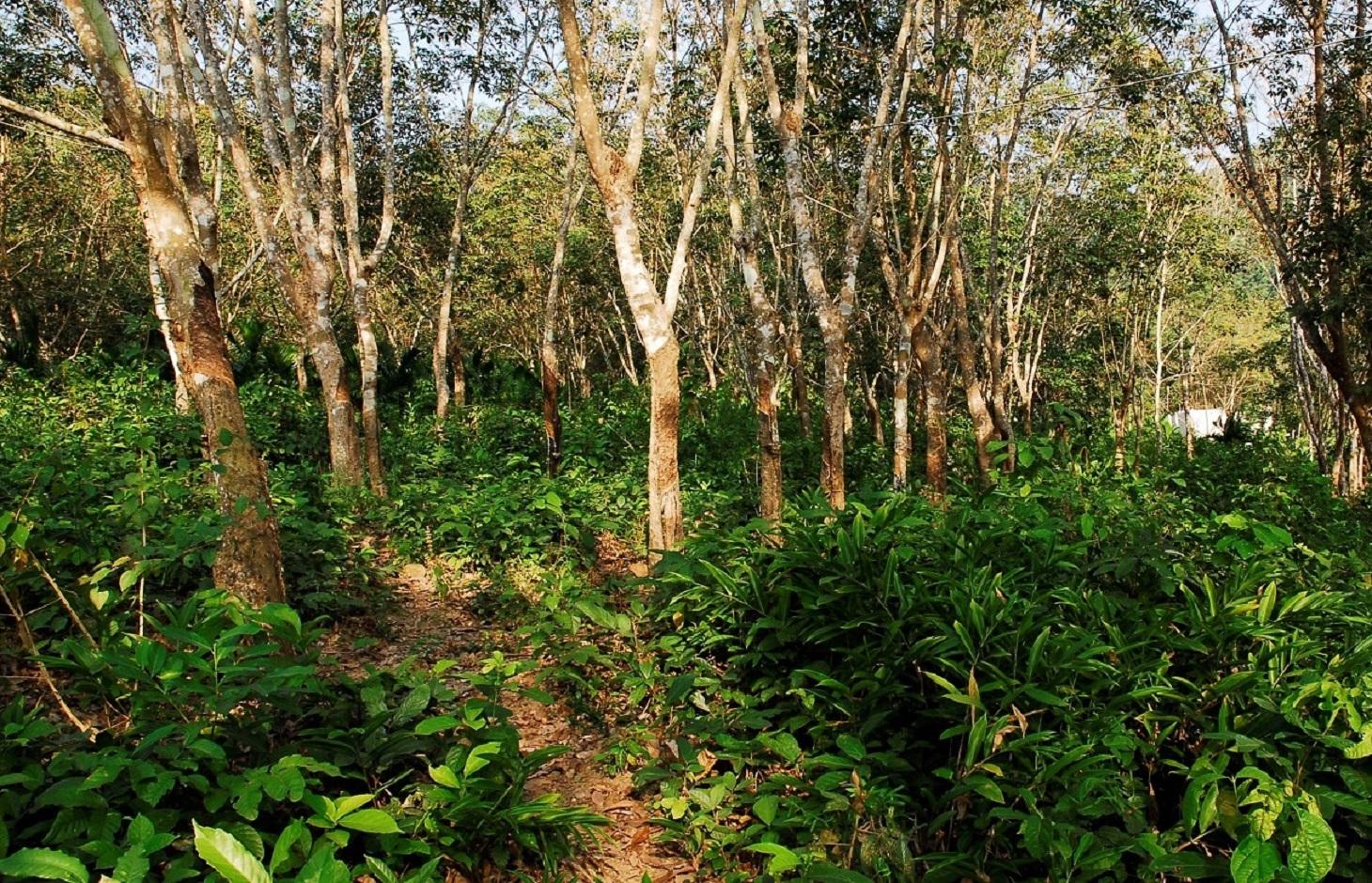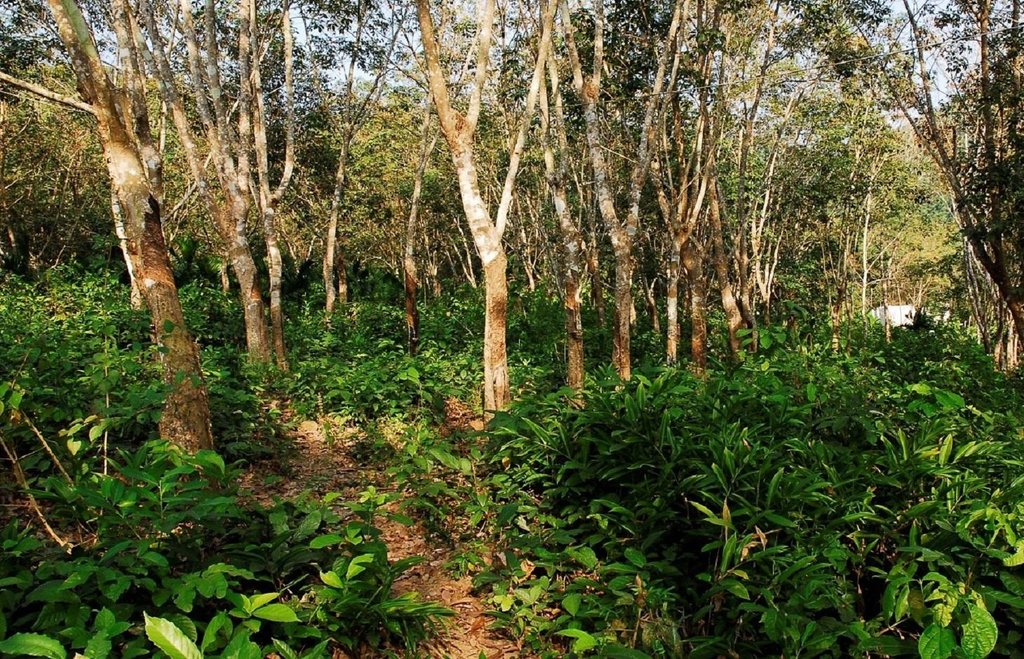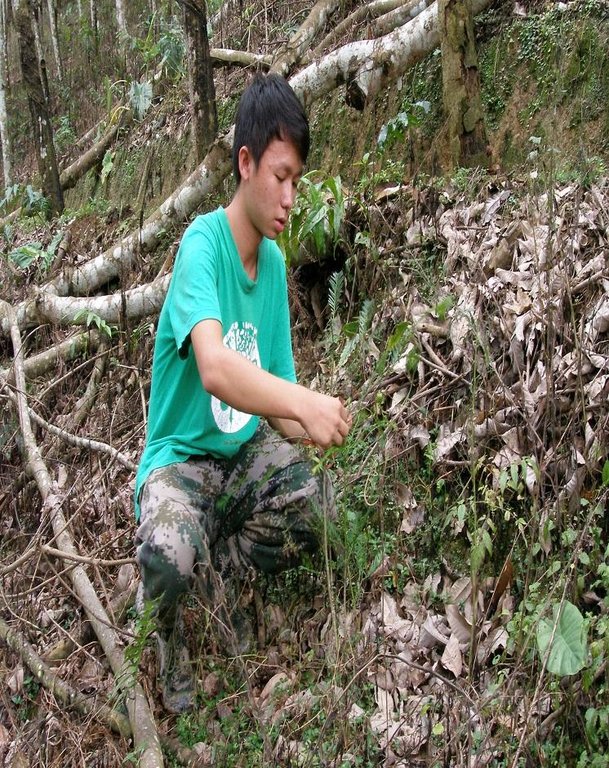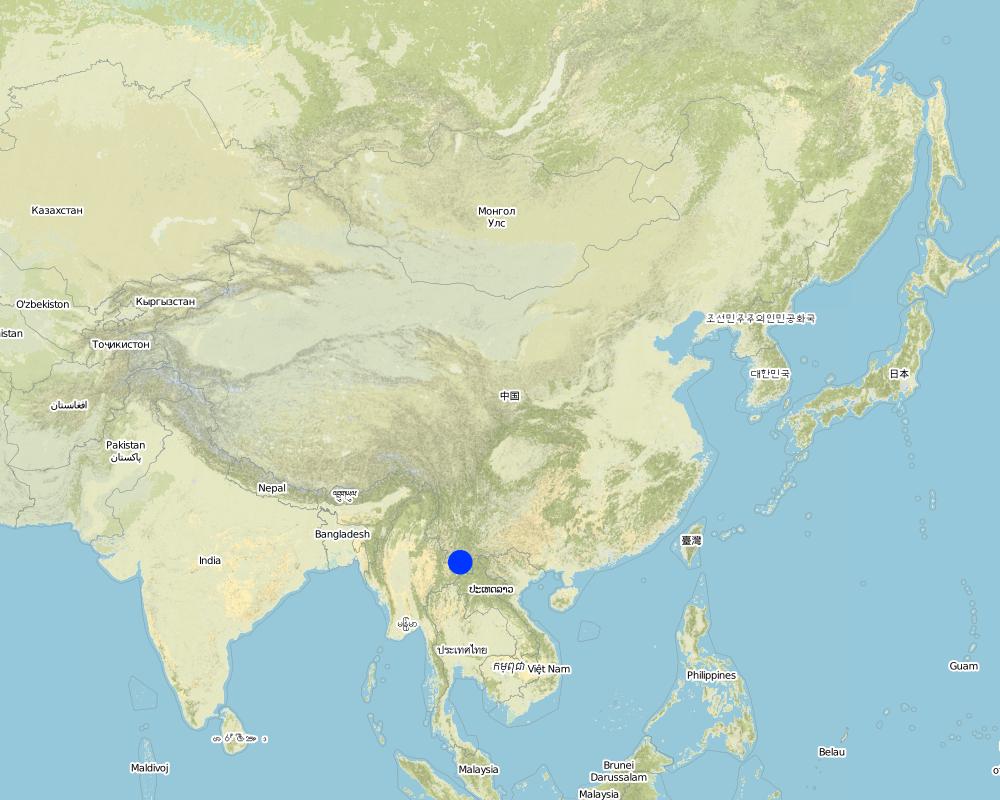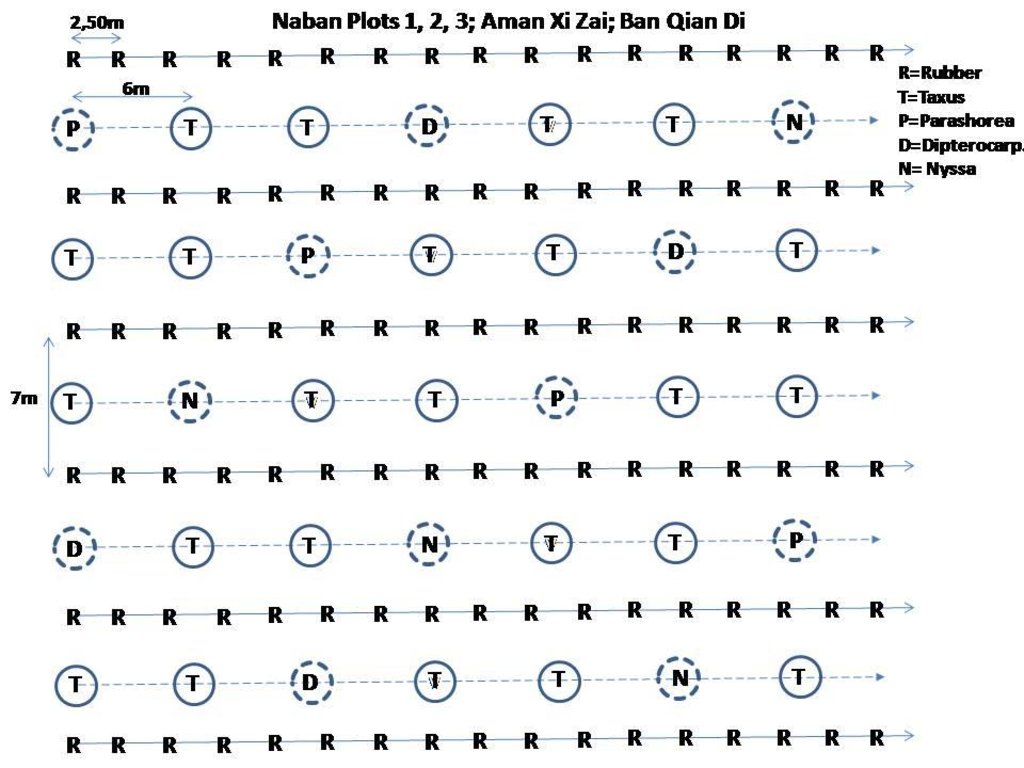Integrating native trees in rubber monocultures [中国]
- 创建:
- 更新:
- 编制者: Gerhard Langenberger
- 编辑者: –
- 审查者: Deborah Niggli
减缓单一橡胶种植的负面环境影响:关于橡胶与当地树种混种并结合杂草管理的生态种植研究 (Chinese)
technologies_1717 - 中国
查看章节
全部展开 全部收起1. 一般信息
1.2 参与该技术评估和文件编制的资源人员和机构的联系方式
SLM专业人员:
SLM专业人员:
Blagodatsky Sergey
University of Hohenheim
德国
有助于对技术进行记录/评估的机构名称(如相关)
Humboldt Universität zu Berlin (HU Berlin) - 德国有助于对技术进行记录/评估的机构名称(如相关)
Universität Hohenheim - 德国有助于对技术进行记录/评估的机构名称(如相关)
China Agricultural University (China Agricultural University) - 中国1.3 关于使用通过WOCAT记录的数据的条件
(现场)数据是什么时候汇编的?:
12/02/2016
编制者和关键资源人员接受有关使用通过WOCAT记录数据的条件。:
是
1.4 所述技术的可持续性声明
这里所描述的技术在土地退化方面是否存在问题,导致无法被认为是一种可持续的土地管理技术?:
否
2. SLM技术的说明
2.1 技术简介
技术定义:
The technology combines the integration of native tree species into rubber monocultures with changed weed management to mitigate negative environmental impacts and to provide alternative income options for farmers.
2.2 技术的详细说明
说明:
Natural rubber is a crucial renewable resource produced from the tree Hevea brasiliensis. Production is largely based on monoculture, often associated with chemical-based clean-weeding. This causes environmental problems such as loss of biodiversity, pesticide pollution and erosion of topsoil. The SLM-technology aims at mitigating negative impacts by interplanting the rubber with native tree species which have economic potential of their own. Changes in weed management are part of the package also.
Native (indigenous) tree species are integrated into mature rubber plantations. Criteria for species selection are: a) adapted to environmental conditions; b) shade tolerant; c) vertical growth not affected by light; d) conservation value; e) economic potential; f) easy to manage. Rubber trees are usually planted in rows at a spacing of 6-8 m, and an intra-row distance of 2.5 to 3 m. The native trees are planted between the rubber rows. The plantation should be mature as the canopy will have reached its highest density, and weed competition is naturally suppressed. The spacing of the native trees needs to be adapted to their growth potential and intended usage. After planting, regular monitoring is necessary to identify pests or diseases. The following species were selected for demonstration sites: 1) Parashorea chinensis, a valuable timber tree, 2) Taxus mairei, a multi-purpose tree, providing good timber but also an anti-cancer drug, taxol, and 3) Nyssa yunnanensis, selected for its conservation value. At the end of the economic life span of the rubber trees (about 30 years) there will be several options, but there are three main ones. First the rubber plantation can be replanted, although the harvest of the Parashorea chinensis trees would be premature. The Taxus mairei trees could be maintained through a new plantation cycle. Second, both, the rubber and the intercropped trees could be maintained for future timber and taxol production. Third, the plantation could be transformed into a sustainable forest managed scheme where the rubber trees are extracted step by step and the intercropped trees maintained for their intrinsic value.
Procedures for the selection and planting of the indigenous tree species are crucial. Identification should be based on suitability for the climate and soil as well as economic potential. The raising of tree seedlings requires experience and nursery propagation by experts might be required. Only healthy seedlings should be used. Planting should take place during rainy periods. Potted seedlings are better than bare-rooted seedlings since they establish better. Generally, weed management (if necessary) should shift from herbicide application to mechanical weeding. Grass competition needs to be avoided in any case! Controlled cover of natural undergrowth will reduce erosion and promote water infiltration.
The implementation site for the trials is located in Xishuangbanna Prefecture, Yunnan Province, SW China. The original vegetation was tropical rain and monsoon forest, but now there is a rich mosaic of different land-use and vegetation types. The whole region is exceptionally species rich and part of the Indo-Burma-Biodiversity Hotspot.
2.3 技术照片
2.5 已应用该技术的、本评估所涵盖的国家/地区/地点
国家:
中国
区域/州/省:
Xishuangbanna Dai Autonomous Prefecture, Yunnan Province, PR China
有关地点的进一步说明:
Naban River Watershed National Nature Reserve
Map
×2.6 实施日期
如果不知道确切的年份,请说明大概的日期:
- 10-50年前
2.7 技术介绍
- review on available knowledge on rubber management and history
注释(项目类型等):
The technology is a result of the synthesis of research findings of the SURUMER-project and a review of available publications on rubber management.
3. SLM技术的分类
3.1 该技术的主要目的
- 改良生产
- 保护生态系统
- 保持/提高生物多样性
3.2 应用该技术的当前土地利用类型

农田
- 乔木与灌木的种植
注释:
Major land use problems (compiler’s opinion): Large-scale expansion of rubber monocultures results in the loss of topsoil and siltation of streams with respective consequences for CO2 emissions (increased), soil degradation, water quality and stream ecology. The excessive application of agrochemicals adds to these problems. The monoculture practice combined with clean weeding results in plant biodiversity loss. The related simplification of habitat structures also leads to a considerable decline in animal biodiversity.
Major land use problems (land users’ perception): The focus of land users is primarily on sustainable income, and their environmental concerns mainly relate to water provisioning (land user's point of view). In the farmers view: “The biggest environmental problem is water quantity. Rubber sucks out a lot of water, therefore we do have a water scarcity problem”. Farmers are aware of the contamination of drinking water due to the use of pesticides and herbicides in the rubber plantations.
Future (final) land use (after implementation of SLM Technology): Mixed: Mf: Agroforestry
Type of cropping system and major crops comments: The majority of farmers shifted to pure rubber growing, although many villages still have paddy rice fields.
3.3 有关土地利用的更多信息
该技术所应用土地的供水:
- 混合雨水灌溉
每年的生长季节数:
- 1
具体说明:
Longest growing period in days: 270, Longest growing period from month to month: April - December
3.4 该技术所属的SLM组
- 农业林学
3.5 技术传播
注释:
Total area covered by the SLM Technology is 0.03 m2.
The technology is currently tested on three trial sites coveríng 3 ha. Some farmers started to adopt and also planted trees in rubber. But no figures are available so far.
3.6 包含该技术的可持续土地管理措施

植物措施
- V1:乔木和灌木覆盖层

管理措施
- M2:改变管理/强度级别
3.7 该技术强调的主要土地退化类型

土壤水蚀
- Wt:表土流失/地表侵蚀
- Wo:场外劣化效应

物理性土壤退化
- Pk:熟化和结壳

生物性退化
- Bc:植被覆盖的减少
- Bh:栖息地丧失
- Bs:质量和物种组成/多样性的下降

水质恶化
- Hs:地表水良变化
- Hp:地表水水质下降
注释:
Main causes of degradation: deforestation / removal of natural vegetation (incl. forest fires) (Replacement of forests by monocultures.), poverty / wealth (Older people still have the memory of extreme poverty. Rubber was the main driver to reduce poverty; high profit gained by rubber encouraged people in pursuit of large scale monoculture.), inputs and infrastructure: (roads, markets, distribution of water points, other, …) (A tremendously improved infrastructure allows the establishment of plantations even in previously remote areas.), governance / institutional (Strong support from government in terms of subsidy and other incentives from 1980s to 2000s; subsidies are more recently reduced)
Secondary causes of degradation: crop management (annual, perennial, tree/shrub) (Clear-weeding, mainly with herbicides.), disturbance of water cycle (infiltration / runoff) (Removal of natural vegetation leads to higher runoff), land tenure (Introduction of Household Responsibility System in 1980s gave use-right to farmers. This pushed decisions on transformating natural forests to monocultures. No full property rights could hinder could), labour availability (Compared to the traditional agricultural system, rubber monocultures require less labour. Recently, there is even less labour available due to the relatively low income gained by rubber), education, access to knowledge and support services (The awareness about ecosystem services and functions is still poorly developed.), war and conflicts (Chinese government´s objective to be independent on important strategic resources such as rubber)
3.8 防止、减少或恢复土地退化
具体数量名该技术与土地退化有关的目标:
- 减少土地退化
- 修复/恢复严重退化的土地
4. 技术规范、实施活动、投入和成本
4.1 该技术的技术图纸
作者:
G. Langenberger, Institute of Agricultural Sciences in the Tropics (490), University of Hohenheim, Germany
4.2 技术规范/技术图纸说明
The concept is based on the commonly suggested planting scheme of rubber with a row distance of ca. 7 m and a spacing of trees within the rows of ca. 2.5 to 3 m, resulting in ca. 450 to 500 trees/ha. The intercropping will take place between the rubber rows, on terraced slopes between the rubber terraces. Planting takes place after the plantations have reached half of their economic life span, which is ca. 15 years. It is important to consider that farmers often plant much denser than suggested by official guidelines, which needs an assessment of the light / shade conditions. With a too high rubber density the resulting light conditions might be too poor for intercropping even for forest trees. In our case the distance within a row of the intercropped trees has been set at 6 m, due to the (known) ecological characteristics of the selected 4 tree species. But the decision needs to be taken specifically for each new site, the potential tree species and the intentions of the land-user. Thus, in our case, we opted for a higher density of Taxus (bold circles) which is well known for its slow growth. and integrated the two other tree species at a wider distance (dotted circles).
Location: Yunnan Province, SW China. Xishuangbanna Prefecture
Date: September 2014
Technical knowledge required for field staff / advisors: high (The selection and management of native tree species requires a very good ecological as well as dendrological knowledge and understanding.)
Technical knowledge required for land users: moderate (If species selection has been successful and management is supported by a knowledgeable extension service.)
Main technical functions: control of dispersed runoff: retain / trap, stabilisation of soil (eg by tree roots against land slides), increase in organic matter, increase of infiltration, promotion of vegetation species and varieties (quality, eg palatable fodder)
Secondary technical functions: control of raindrop splash, improvement of surface structure (crusting, sealing), improvement of topsoil structure (compaction), increase / maintain water stored in soil, increase of groundwater level / recharge of groundwater
Aligned: -contour
Vegetative material: T : trees / shrubs
Vegetative measure: Intercropping of native tree species
Vegetative material: T : trees / shrubs
Number of plants per (ha): 240
Spacing between rows / strips / blocks (m): 7 m
Vertical interval within rows / strips / blocks (m): 6 m
Vegetative measure: Vegetative material: T : trees / shrubs
Trees/ shrubs species: Parashorea chinensis, Taxus mairei, Nyssa yunnanensis: all planted (container-planting)
Slope (which determines the spacing indicated above): 0-80%
Gradient along the rows / strips: 0%
Change of land use practices / intensity level: Shift from herbicide-based weed management to mechanical weeding with machine tools. This has not yet been implemented due lack of experience and proper tools.
4.3 有关投入和成本计算的一般信息
其它/国家货币(具体说明):
RMB
注明美元与当地货币的汇率(如相关):1美元=:
6.3
注明雇用劳工的每日平均工资成本:
16.00
4.4 技术建立活动
| 活动 | 措施类型 | 时间 | |
|---|---|---|---|
| 1. | 1. Seedling acquisition and transport | 植物性的 | before or during rainy season |
| 2. | 2. Planting of seedlings in rainy season | 植物性的 | rainy season |
| 3. | Weed management with brush cutters. | 管理 | ? no experience |
4.5 技术建立所需要的费用和投入
| 对投入进行具体说明 | 单位 | 数量 | 单位成本 | 每项投入的总成本 | 土地使用者承担的成本% | |
|---|---|---|---|---|---|---|
| 劳动力 | labour | ha | 1.0 | 80.0 | 80.0 | 100.0 |
| 设备 | machine use | ha | 1.0 | 80.0 | 80.0 | |
| 设备 | animal traction | ha | 1.0 | 8.0 | 8.0 | 100.0 |
| 植物材料 | seedlings | ha | 1.0 | 2400.0 | 2400.0 | |
| 技术建立所需总成本 | 2568.0 | |||||
注释:
Duration of establishment phase: 0.07 month(s)
4.6 维护/经常性活动
| 活动 | 措施类型 | 时间/频率 | |
|---|---|---|---|
| 1. | 1. Control of pests and diseases | 植物性的 | monthly |
4.7 维护/经常性活动所需要的费用和投入(每年)
| 对投入进行具体说明 | 单位 | 数量 | 单位成本 | 每项投入的总成本 | 土地使用者承担的成本% | |
|---|---|---|---|---|---|---|
| 劳动力 | labour | ha | 1.0 | 96.0 | 96.0 | 100.0 |
| 技术维护所需总成本 | 96.0 | |||||
注释:
The costs are based on the establishment of 3 demonstration plots of ca. 1 ha each. It should be possible to considerably reduce the costs by producing seedlings on site.
4.8 影响成本的最重要因素
描述影响成本的最决定性因素:
Seedling costs are by far the major cost factor. Since the selected species are very unusual and don't have a considerable market they were extremely expensive. Since Taxus is also a reputed medicinal plant, it might also have influenced the price. All other costs are actually negligible compared to the costs of the seedlings. In this case the establishment of an own nursery might considerably reduce the costs, since propagation at least of Taxus and Parashorea is easy if the seeds can be acquired.
5. 自然和人文环境
5.1 气候
年降雨量
- < 250毫米
- 251-500毫米
- 501-750毫米
- 751-1,000毫米
- 1,001-1,500毫米
- 1,501-2,000毫米
- 2,001-3,000毫米
- 3,001-4,000毫米
- > 4,000毫米
农业气候带
- 半湿润
Thermal climate class: subtropics
5.2 地形
平均坡度:
- 水平(0-2%)
- 缓降(3-5%)
- 平缓(6-10%)
- 滚坡(11-15%)
- 崎岖(16-30%)
- 陡峭(31-60%)
- 非常陡峭(>60%)
地形:
- 高原/平原
- 山脊
- 山坡
- 山地斜坡
- 麓坡
- 谷底
垂直分布带:
- 0-100 m a.s.l.
- 101-500 m a.s.l.
- 501-1,000 m a.s.l.
- 1,001-1,500 m a.s.l.
- 1,501-2,000 m a.s.l.
- 2,001-2,500 m a.s.l.
- 2,501-3,000 m a.s.l.
- 3,001-4,000 m a.s.l.
- > 4,000 m a.s.l.
5.3 土壤
平均土层深度:
- 非常浅(0-20厘米)
- 浅(21-50厘米)
- 中等深度(51-80厘米)
- 深(81-120厘米)
- 非常深(> 120厘米)
土壤质地(表土):
- 中粒(壤土、粉土)
- 细粒/重质(粘土)
表土有机质:
- 中(1-3%)
5.4 水资源可用性和质量
地表水的可用性:
好
水质(未处理):
不良饮用水(需要处理)
5.5 生物多样性
物种多样性:
- 高
5.6 应用该技术的土地使用者的特征
生产系统的市场定位:
- 商业/市场
非农收入:
- 收入的10-50%
相对财富水平:
- 贫瘠
- 平均水平
个人或集体:
- 个人/家庭
机械化水平:
- 手工作业
性别:
- 男人
说明土地使用者的其他有关特征:
Land users applying the Technology are mainly Leaders / privileged
Difference in the involvement of women and men: So far, the number of persons applying the technology is still too low to draw any meaningful conclusion.
Population density: 10-50 persons/km2
Annual population growth: < 0.5% (farmers have been well off in the past, currently they are under pressure due to the very low rubber).
5.7 应用该技术的土地使用者拥有或租用的平均土地面积
- < 0.5 公顷
- 0.5-1 公顷
- 1-2 公顷
- 2-5公顷
- 5-15公顷
- 15-50公顷
- 50-100公顷
- 100-500公顷
- 500-1,000公顷
- 1,000-10,000公顷
- > 10,000公顷
这被认为是小规模、中规模还是大规模的(参照当地实际情况)?:
- 小规模的
5.8 土地所有权、土地使用权和水使用权
土地所有权:
- 州
土地使用权:
- 个人
注释:
Water use rights seem to be an issue.
5.9 进入服务和基础设施的通道
健康:
- 贫瘠
- 适度的
- 好
教育:
- 贫瘠
- 适度的
- 好
技术援助:
- 贫瘠
- 适度的
- 好
就业(例如非农):
- 贫瘠
- 适度的
- 好
市场:
- 贫瘠
- 适度的
- 好
能源:
- 贫瘠
- 适度的
- 好
道路和交通:
- 贫瘠
- 适度的
- 好
饮用水和卫生设施:
- 贫瘠
- 适度的
- 好
6. 影响和结论性说明
6.1 该技术的现场影响
社会经济效应
生产
木材生产
注释/具体说明:
considerably, but no experience
收入和成本
工作量
注释/具体说明:
no practical experience, yet
社会文化影响
冲突缓解
生态影响
水循环/径流
水质
注释/具体说明:
less erosion
地表径流
注释/具体说明:
cf. Hongxi
土壤
土壤覆盖层
注释/具体说明:
compared to clear-weeding
生物多样性:植被、动物
生物量/地上C
注释/具体说明:
cf. Xueqing
6.2 该技术的场外影响已经显现
下游淤积
地下水/河流污染
缓冲/过滤能力
6.3 技术对渐变气候以及与气候相关的极端情况/灾害的暴露和敏感性(土地使用者认为的极端情况/灾害)
渐变气候
渐变气候
| 季节 | 气候变化/极端天气的类型 | 该技术是如何应对的? | |
|---|---|---|---|
| 年温度 | 增加 | 好 |
气候有关的极端情况(灾害)
气象灾害
| 该技术是如何应对的? | |
|---|---|
| 局地暴雨 | 好 |
| 局地风暴 | 未知 |
气候灾害
| 该技术是如何应对的? | |
|---|---|
| 干旱 | 不好 |
水文灾害
| 该技术是如何应对的? | |
|---|---|
| 比较和缓的(河道)洪水 | 未知 |
其他气候相关的后果
其他气候相关的后果
| 该技术是如何应对的? | |
|---|---|
| 缩短生长期 | 不好 |
| cold spells | 不好 |
注释:
The above assessment is based on the fact that we are actually dealing with plants adapted to tropical conditions. Therefore, the species should be less affected by high temperatures and increasing rainfall, but might be sensitive to droughts. Nevertheless, there is no experience!
6.4 成本效益分析
技术收益与技术建立成本相比如何(从土地使用者的角度看)?
短期回报:
消极
长期回报:
积极
技术收益与技术维护成本/经常性成本相比如何(从土地使用者的角度看)?
短期回报:
积极
长期回报:
非常积极
注释:
The establishment costs for the demo-sites have been very high, but could be considerably reduced if adopted by more farmers. The assessment above therefore needs verification!
6.5 技术采用
注释:
100% of land user families have adopted the Technology with external material support
3 land user families have adopted the Technology with external material support
There is a little trend towards spontaneous adoption of the Technology. Comments on adoption trend: We experienced interest in the technology by farmers, but due to the lack of experience and the lack of affordable and accessible seedlings they are hesitant.
6.7 该技术的优点/长处/机会
| 土地使用者眼中的长处/优势/机会 |
|---|
| Additional income options. |
| 编制者或其他关键资源人员认为的长处/优势/机会 |
|---|
| The technology offers considerable long-term advantageous to farmers. It diversifies the product portfolio and good options for additional income in the future. Beyond the establishment it doesn't require much labour. |
6.8 技术的弱点/缺点/风险及其克服方法
| 土地使用者认为的弱点/缺点/风险 | 如何克服它们? |
|---|---|
| High investment costs. | Government subsidies. |
| Time until first returns can be expected. 5-10 years for taxol production |
| 编制者或其他关键资源人员认为的弱点/缺点/风险 | 如何克服它们? |
|---|---|
| The technology is based on a long-term perspective and thus favours farmers who have a such an outlook. But farmers with little land usually think short-term. | The current trend of rural-urban migration will support the technology since it can be easily combined with off-farm work. According to SURUMER findings off-farm income already contributes about one third of the overall household income in the rubber growing areas. |
| Current establishment costs are very high due to the lack of a seedling market. | If the technology becomes known and popular, more nurseries will produce seedlings which will reduce costs. Alternatively, farmers might establish their individual (or community) nurseries. |
| The technology requires considerable knowledge about tree ecology and tree breeding. | There should be extension officers at the local agricultural or forestry bureaus supporting farmers. |
7. 参考和链接
7.1 信息的方法/来源
- 实地考察、实地调查
- 与土地使用者的访谈
7.2 参考可用出版物
标题、作者、年份、ISBN:
Ahrends, A. et al. (2015) Current trends of rubber plantation expansion may threaten biodiversity and livelihoods
可以从哪里获得?成本如何?
Global Environ Change, 34, 48-58.
标题、作者、年份、ISBN:
Langenberger, G. et al. (2016) Rubber intercropping: a viable concept for the 21st century?
可以从哪里获得?成本如何?
Agrofor Syst, 1-20.
标题、作者、年份、ISBN:
Liu, H. et al. (2016) Impact of herbicide application on soil erosion and induced carbon loss in a rubber plantation of Southwest China
可以从哪里获得?成本如何?
CATENA, 145, 180-192.
链接和模块
全部展开 全部收起链接
无链接
模块
无模块


